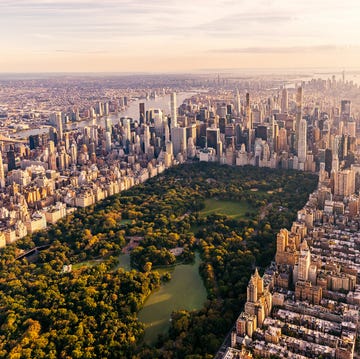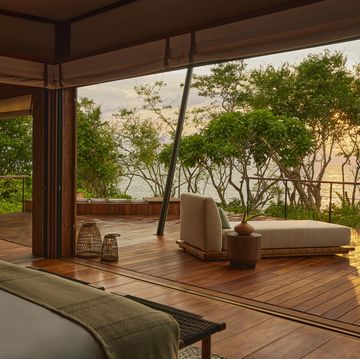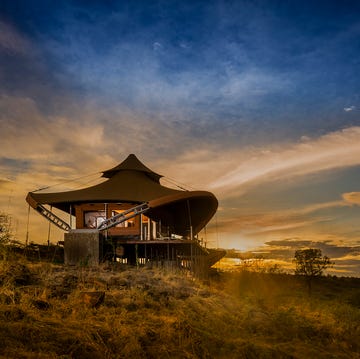All it took was a visit to Nagao Hoyuen in the mountains of Ureshino, Japan, as part of an intimate and immersive culinary week I spent with Mirukashi Salon in nearby Karatsu. These bespoke and intimate five-day sessions by Prairie Stuart-Wolff introduce guests to Japan’s microseasons that center around culinary practice, foraging and harvest, the region’s pottery traditions, and more. On a day trip to Ureshino, I met next-generation tea farmer Yuya Nagao, 45, who has taken the heritage of his ancestors who have cultivated tea on these terraced hillsides for centuries, and created a new, immersive experience for visitors like me.
Amid the immaculately tended fields of shrubby, knee-high tea trees that Nagao and his father tend assiduously lies one square plot surrounded on four sides by tall stands of cedar and cypress. In the center of this verdant garden room sits a broad platform elevated just enough so that it appears to float amid waves of green.
Here, clad all in white, Nagao welcomes our party of six visitors to the platform and performs a traditional tea ceremony in near silence, then offers three more rounds of the ancient Camellia sinensis, the single great botanical source of teas ranging from Earl Grey and white peony to matcha.
More From Veranda

We watch Nagao’s careful measuring, brewing, and pouring of umami-forward green tea (okuyutaka), then a slightly sweeter Japanese black tea, then a matcha pour, and finally a delicate, chilled tea—each paired with a sweet confection. It’s tasting menu meets meditation, and with the cedar and cypress rustling and the sun shining down, it’s as transformative as any wellness retreat.
And here in Ureshino, this is just one way to be a happy, mildly caffeinated tea tourist.
Nagao is one of four young inheritors of the region’s 500-year tradition of cultivating tea of the highest quality (credit the region’s topography and microclimate as well as proximity to Korea and early influence from Chinese growers). His counterparts, like him, have added outdoor tea tasting rooms to their family farms, while also branding and packaging their teas for boutique sale in the Ureshino valley and online.
It’s an artisan movement right at home with myriad high-craft culinary offerings increasingly driving travel both foreign and domestic. Much like we’d spend days tasting wines in Sonoma or the North Fork of Long Island, chasing olive oils on Sicily or sea salt in Ireland, here in Ureshino we can not only migrate from tasting platform to tasting platform but hire tea butlers to guide special tastings and rent special tea bikes for exploring the region on two wheels. Further, we can enjoy the additional historic riches of Ureshino: its famed hot springs and traditional Hizen-Yoshida porcelain pottery. (In fact, aficionados of Ureshino tea declare that the only way to best brew and enjoy it is in Hizen-Yoshida vessels.)
Are there other parts of Japan where one can feel the ultimate tea tourist? Absolutely. Shizuoka Prefecture is one of the country’s largest tea-producing areas and home to the Fuji no Kuni Tea Museum (set on the largest tea farm in Japan). In the town of Uji just south of Kyoto, pilgrims can pay homage to the world’s oldest tea shop, Tsuen Tea, which has been in business since 1160 and is still known for its green tea parfaits and rice dumplings. Like Ureshino, Uji is appropriately tea-forward: There’s an annual tea festival and a street, Byodo-in Omotesando, lined with shops full of tea-related treasures where one can also participate in the traditional tea ceremony.
In other words, Japan embraces the tea tourist, the traveler seeking a beautiful, mindful moment with a vessel, where hot water and a leaf meet to create singular experiences, where ancient practice meets modern life. And Yuya Nagao, on his heavenly platform on a sea of tea, awaits his next delighted visitor.
Consider immersing yourself in tea culture and more with Mirukashi Salon through intimate sessions led by Prairie Stuart-Wolff and tuned to Japan’s microseasons. For schedules and itineraries, go to mirukashi.life (or follow along on Instagram). For more information on tea tourism in Ureshino, go to www.tea-tourism.com. Experts advise that the best time for tea tourism in Japan is October and November, or in mid-spring when fresh tea leaves are harvested.















